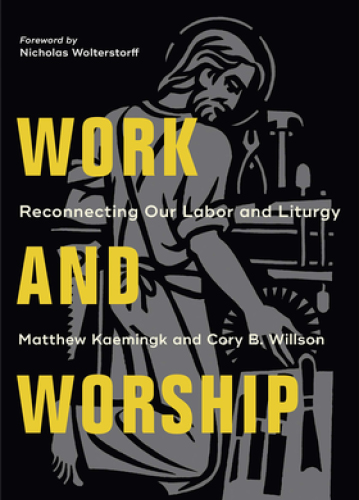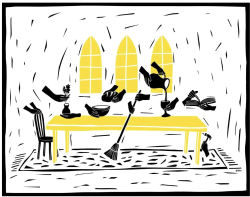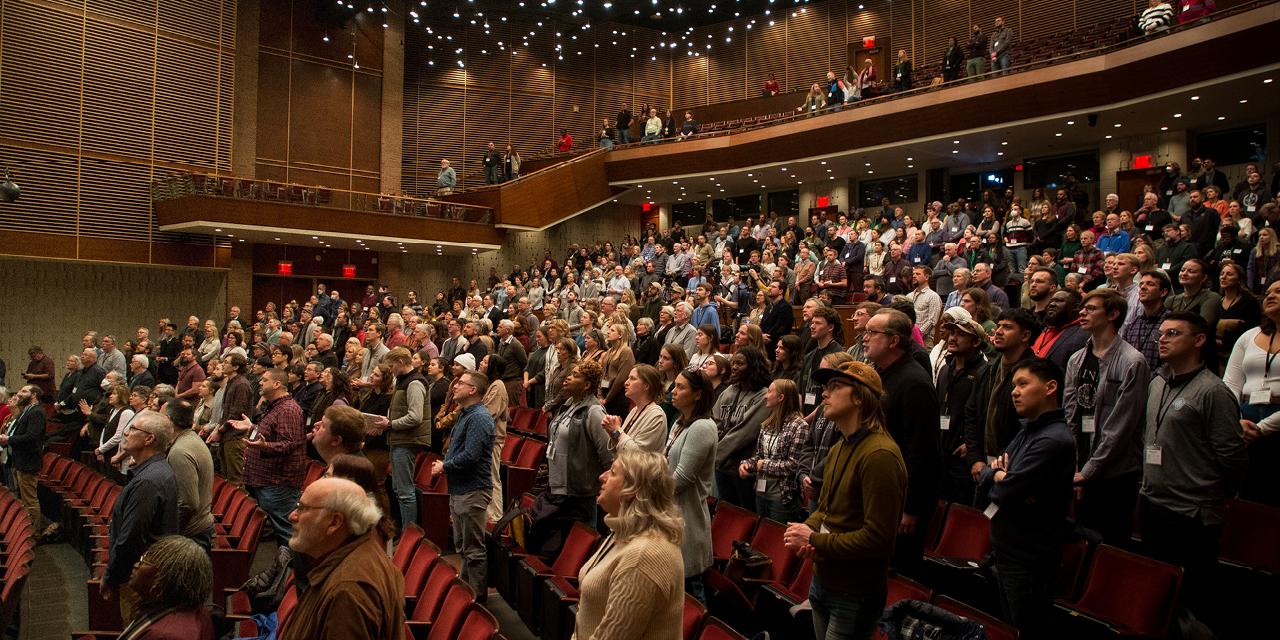Maybe this has happened to you: Try as you might to pay attention to the worship service, your mind keeps drifting to a work project that interests you, a promotion you’d hoped for, or your relationship with a coworker. You ask God to forgive you for letting work intrude in worship.
But imagine being welcomed to worship with an invitation that includes “Perhaps your hands are calloused, blistered, or arthritic from the physical labor or crafting God has called you to.” How might it feel to join in a sung refrain that gives you permission to “Bring it to the altar, lay it on the stone, every sorrow and every joy. . . . Whatever you carry, come and give it to the Lord”? Consider how meaningful it might be for your congregation to commission retirees.
“Worship is not a place to go to escape from our labors. It is the very best place to bring them (to) be formed, be renewed, and be equipped,” says Katie Roelofs, a minister in the Christian Reformed Church who has been involved in music and worship ministry for seventeen years. She previously served a congregation in Washington, DC, and now works both with Worship for Workers and as the worship consultant for her denomination.
Roelofs explains how a book launched the Worship for Workers initiative. Its website has worship resources that can spark imagination in your worshiping community, help people recognize what God sees as work, and help them bring their whole selves to God.
Read the book that launched a movement
Roelofs describes the book Work and Worship: Reconnecting Our Labor and Liturgy (Baker Academic, 2020) by Matthew Kaemingk and Cory Willson as “a theologically rich book about worship that gathers and scatters workers.”
Kaemingk has been researching, teaching, and leading in the area of marketplace ministry for the past fifteen years. He teaches at Fuller Seminary, where he serves as the director of the Mouw Institute for Faith and Public Life.
Willson’s dissertation on an embodied theology of work informed Work and Worship. Willson teaches at Calvin Theological Seminary and often talks about how he and Kaemingk built on philosopher Nicholas Wolterstorff’s idea of bringing trumpets of praise, tears of lament, ashes of repentance, and petitions from daily life into worship.
“Matt’s wife, Heather, is a long-time worship director and was the perfect voice for pushing in the direction of praxis for church leaders,” Roelofs says. “Conceptually, everything was there in the book. But the ideas have to be accessible to worship leaders and pastors. The Worship for Workers initiative seeks to answer the question of how you actually embody a theology of work in your local context, even when your church isn’t accustomed to it or is resistant.
Worship for Workers began in 2022 with funding from several partnering organizations who “saw the vision and wanted to help,” Roelofs says.
In early 2022, Kaemingk gathered a monthly virtual cohort of worship leaders, including Roelofs, to read and discuss Work and Worship and write liturgy. In August 2022, Roelofs became Worship for Workers’ project director. Kaemingk is project lead. Roelofs, Kaemingk, and Willson lead trainings, workshops, and seminars on the topic.

Use, adapt, and contribute to ever-growing resources
“2023 was a huge year for us,” Roelofs says. “We rolled out our new website in January 2023. Together with our partners we began producing songs, prayers, blessings, art, and liturgies that deeply engage the realities of people’s callings and careers. We began with 150+ liturgical resources written by more than a hundred writers from many different ecumenical traditions. Our mission is to freely share these resources with diverse congregations and organizations who care about reconnecting the work and worship of God’s people.”
The initiative commissioned The Porter’s Gate to create songs for the Worship for Workers album. As the 2023 album was slowly released, song by song, the website filled with related songs, prayers, liturgies, and art. For example, going to the songs search box and entering either “Porter’s Gate” or “Breastplate of St. Patrick” will bring up a song by Wendell Kimbrough and Dan Wheeler that begins: “When my work takes me places I don’t wanna go: Christ before me. When my heart aches with sorrow as I hit the road: Christ be with me.” You’ll also find related prayers, a lament, confession, Scripture litany, and benediction and charge.
Worship for Workers’ original songs include “Cloister Song: Steadfast Love,” “The Grind,” and “God, You Know the Way.” Using tags such as “call to worship,” “lament,” “praise,” and “benediction” will yield resources for various worship elements. Roelofs and Kaemingk welcome submissions. Each accepted submission will be liturgically edited before being uploaded to the website.
“In our first eight months, we welcomed 42,000 unique visitors to our website from ninety-nine different countries,” Roelofs says. “During that time the Worship for Workers album was streamed 2.3 million times over various platforms. With ever-growing content and contributors, we had to switch platforms and redesign the website in fall 2023. We’re so grateful for web designer Leslie Eiler Thompson.”

Recognize what God sees as work
Many books, articles, and websites about faith, work, and worship seem to be mainly for white-collar workers who have some agency and control in their work lives. Worship for Workers casts a broader net.
“‘Work’ looks like a lot more than a nine-to-five office job,” Roelofs says. “Not only does it include the working class, but it also needs to speak to stay-at-home parents, retirees, those seeking employment, and much more.” That’s why the website has prayers for cybersecurity workers and medical professionals as well as resources that recognize the work of parents, grandparents, and unseen laborers.
The website’s “All of Life Interviews” blog post explains how to interview workers and pray for specific categories during worship. From the Worship for Workers Facebook group, it’s evident that congregations in Canada and the US have adopted or adapted this idea.
“We’ve also started conversations with partners about how to begin establishing theologically and biblically solid understandings of work for children and youth,” Roelofs says. “What they do in their daily ‘work’ matters to God too. And worship is the place that will form them as they create, grow, learn, and do what God has equipped them to do and what God delights in them doing.” Example liturgies include a backpack blessing and an invitation for children to bring their creative work—Lego or clay creations, pictures, poems, or other work—to the altar.
Worship for Workers, in partnership with Made to Flourish, is commissioning The Porter’s Gate to release an album of sending songs in 2024. As a long-time worship pastor, Roelofs says, “I have looked high and low for good sending songs. We tend to either close with doxologies or eschatological songs. Doxologies are beautiful and so needed in worship. But they don’t do the work of sending.
“Constance Cherry says sending should include both a charge and a blessing. Doxologies do neither!” Roelofs notes. “Eschatological songs are common closing songs, and they send us—but toward something very different from Monday’s work. They point us toward the City, but not necessarily toward our city. God sends us and blesses us not only to long for what is to come, but to actively work towards what God is already doing—in our homes, our workplaces, and our daily living!”
Spark imagination in your context
Like Kaemingk and Willson’s Work and Worship book, the Worship for Workers project is meant to spark imagination rather than prescribe a single template for each congregation and context to follow. In fall 2023, Roelofs consulted with First Christian Reformed Church in Barrie, Ontario, on its full worship series based on the themes in Work and Worship.
“One big takeaway is that for this to work in a church, it needs to be the work of the whole staff team. The worship planner or the pastor can’t do it alone,” Roelofs says. “In this church, we saw the beauty of collaboration and holistic integration. Preachers preached. Pastors led small group Bible studies in workplaces.”
The Barrie church staff asked the congregation, “Where will you be at 10 a.m. on Monday?” They invited worshipers to send in photos showing what they do and with whom they meet. Contributions flowed in from people who do paid or volunteer work in childcare, technology, healthcare, education, retail, farming, woodworking, groundskeeping, and more. These photos were inserted into a short video that helped people “pray for the place you will be, for the work you’ve been given to do, and for the people you will serve.” The soundtrack included an instrumental version of John L. Bell’s song “Take, O Take Me as I Am.”
“Our favorite conversations are those with people we’ve never met who say, ‘I found your resources and love them. I have a few questions and suggestions,’” Roelofs says. “We want to learn more about what worship and worship look like in BIPOC communities but also recognize that this is slow and patient work built on relationships, experience, and mutual trust. We look forward to tracking and learning with Theology of Work Project’s Cuentistas Program to equip Hispanic pastors to preach their own stories through a gospel lens.”
With support from a 2024 Vital Worship, Vital Preaching Teacher-Scholar Grant, Kaemingk and Ritsema are writing a handbook with very practical “how-to” advice for pastors, preachers, and worship leaders who want to implement vocationally conversant worship in their church’s worship practices.
Bring your whole selves to God
As helpful as Worship for Workers resources are, Roelofs sees them as a secondary goal. Some churches may cut and paste resources for a one-off liturgy to pray for teachers and students in August or for accountants during tax season. But she hopes church leaders “would begin to imagine and reimagine how these resources could help congregants begin to experience God’s presence in their daily living in new ways.”
“This isn’t a ‘controversial’ issue in the same way many other things have become in the church,” she says. “This is God’s gracious invitation to worship with your fullest self. God wants all of us present. This includes our fight with a coworker, our desperation to make ends meet, or the joy over a promotion. How we distort our view of God when we say, ‘That doesn’t belong in worship. God doesn’t want to hear that or know that. My siblings in Christ don’t need to know that about me.’
“At the heart of worship for workers is an invitation for honest dialogue with the God who not only tolerates it but welcomes it and desires it. Come as you are. For God welcomes you and so do we. As a community of faith, we grow together, we learn together, sometimes we fail together. But the real work of spiritual growth can only happen in spaces of honesty and authenticity.”
Learn More
Gather a group to read and discuss Work and Worship: Reconnecting Our Labor and Liturgy. Listen to the Worship for Workers album. Browse the Worship for Workers website. Join the Worship for Workers Facebook group.
Two helpful resources for how to interview and pray for workers in worship are “All of Life Interviews” and “The Butcher, the Baker, and the Biotech Maker.” Katie Roelofs recommends the picture book The Creator in You, by Jordan Raynor, as a starting point for a children’s message: “It does a beautiful job of extending the Creator’s invitation to us to “Create! Make! Work! Delight!”
Jeff Haanan’s December 2023 Christianity Today review of Andrew Lynn’s book Saving the Protestant Ethic: Creative Class Evangelicalism and the Crisis of Work says that the faith-and-work movement has focused far more on professionals with power and influence than on laborers, worker rights, or centering identities on who we are in Christ rather than on our job titles.
Explore work and worship resources from Worship for Workers’ partners and sponsors. Read this interview with The Theology of Work Project. Its Cuentistas Program equips Hispanic pastors to preach their own stories through a gospel lens. Because so many Hispanic pastors are bivocational, Cuentistas will likely yield valuable sermon ideas for preaching that engages workers in worship.
The Porter’s Gate 2017 Work Songs album includes songs that many congregations have already added to their worship music repertoire, such as “In the Fields of the Lord” and “Your Labor Is Not in Vain.”

